In a call center, taking inbound calls is very different from placing outbound calls. And we’re not just talking about the surface-level call scripts. You’ve got to think about the back-end logistics like dialing capacity, call routing, caller ID, compliance, workforce management, and, of course, legal requirements.
Contact center operators should set up their call centers to handle both call directions. Proper planning now will save you a lot of time and work later when you need to scale sales or customer support workflows — or both at the same time. This guide explains the clear differences between inbound and outbound call centers, their functions, which works for you, and how you can use both to build positive customer experiences and business growth.
Inbound vs. Outbound Call Centers At a Glance
The main difference between inbound and outbound call centers is “who initiates the call.”
Inbound call centers receive inbound calls from customers. Customers who need support, information, or problem resolution initiate these calls. Inbound call centers focus on reactive action and excellent customer service.
Outbound call centers make outbound calls to customers or prospects. Agents initiate these calls for sales, lead generation, market research, or follow-up. Outbound call centers proactively reach out to and retain individual customers.
| Feature | Inbound call centers | Outbound call centers |
|---|---|---|
| Call initiation | Customer calls the business | Call center agent calls the customer/prospect |
| Goal | Customer service, support, and issue resolution | Sales, lead generation, market research |
| Approach | Reactive | Proactive |
| Call type | Customer service, tech support, inquiries, orders | Cold calls, sales calls, follow-ups, surveys |
| Agent skills needed | Empathy, problem-solving, and product knowledge | Persuasion, objection handling, and sales techniques |
Here’s a deeper dive into both types:
What Are Inbound Call Centers?
Inbound call centers receive incoming calls from current customers. Agents respond to these calls and resolve customer issues as they arise, making the call center teams reactive. These teams strive to serve customers and support them when they’re struggling to solve issues independently, even after trying self-serve options in many cases.
For example, a customer calls an inbound call center to inquire about a delayed delivery of an online order and requests an update on the status and the new estimated arrival time.
Calling a company for support is still the most popular inbound contact method today. According to CFI Group, 76% of consumers still prefer using a phone for customer service:
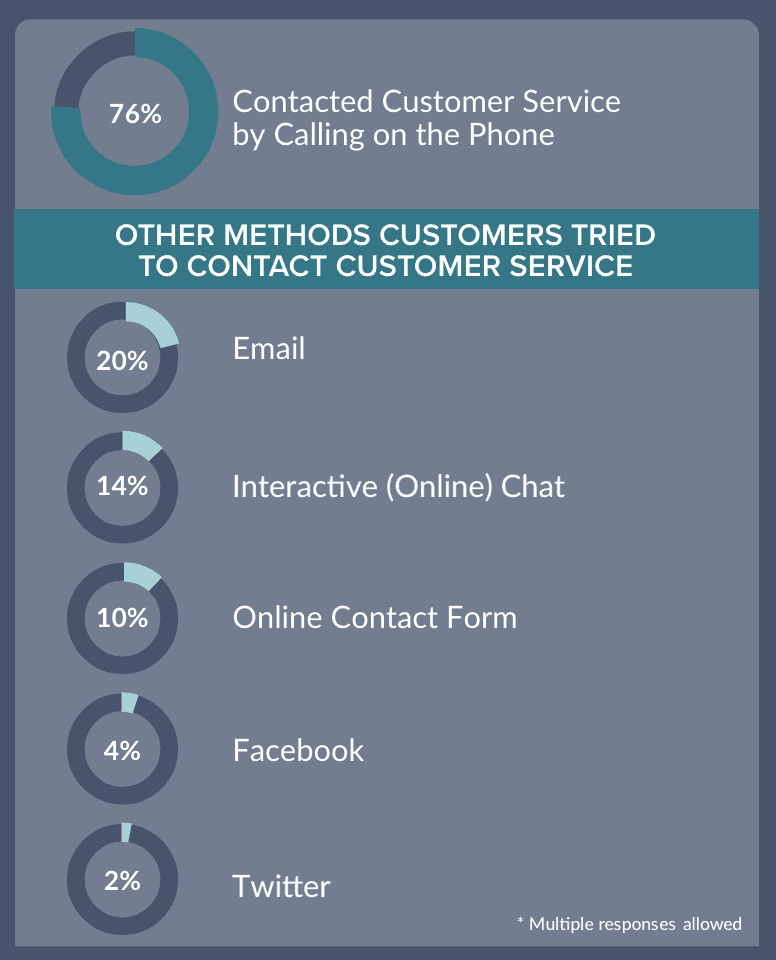
You need empathetic and well-trained staff to ensure customers feel heard and valued. This is key to satisfying customers and retaining them.
Types of inbound calls
Inbound calls include a variety of customer-initiated interactions:
- Customer service calls: Customers needing assistance with products, services, or policies (e.g., order tracking, return requests, general inquiries).
- Technical support calls: Customers experiencing issues with a product or service and need troubleshooting help or support (e.g., setting up a new device, software issues).
- Sales inquiries/ordering: Potential customers calling to inquire about products or pricing, or to place an order after seeing an advertisement or visiting a website.
- Billing and account inquiries: Customers calling with questions about their bills, payments, or to update their account information.
- Complaints: Customers expressing dissatisfaction and seeking a resolution to a negative experience.
- Appointment scheduling: Customers calling to book, reschedule, or cancel appointments.
Inbound call center success KPIs
Call center leaders usually use the following call center metrics to optimize the efficiency and effectiveness of inbound teams.
- Customer satisfaction score (CSAT): (Number of positive responses ÷ total number of responses) × 100
- Customer dissatisfaction score: (Number of negative responses ÷ total number of responses) × 100
- Net promoter score (NPS): [(Number of promoters − number of detractors) ÷ total number of responses] × 100
- First contact resolution rate (FCR): (Number of issues resolved in first contact ÷ total number of issues) × 100
- Average speed of answer (ASA): Measures the average time it takes for an agent to answer a call.
- Call abandonment rate: Percentage of callers who hang up before reaching an agent.
Inbound call center benefits
Below are some notable benefits of adding an inbound call center software to your business.
Build customer loyalty
Customers who receive excellent service via your inbound call center will remain loyal to your brand and think of you when they’re ready to purchase again. On the contrary, customers with not-so-excellent customer service experiences with your inbound call center team will likely switch brands. Poor phone-based interactions frustrate around 76% of customers.
Collect customer feedback
Inbound calls are reliable channels for understanding customers’ general pains, needs, and preferences. Use customer feedback to improve your product and service, creating a more satisfactory customer experience. Feedback helps you continuously improve and build a better product for people who use and purchase it. Inbound call center teams review customer feedback and turn it into action items for their teams.
Retain more customers
A personalized support experience encourages customers to contact you with any issue they have. When you deliver consistently high-quality technical support during every customer interaction, customers know you value them every time they contact you. Customers feel special, which boosts customer loyalty for an extended period of time.

What Are Outbound Call Centers?
Outbound call centers take a more proactive approach than inbound call centers. Agents call new and existing customers to generate leads or conduct market research. Outbound call center agents need to be persuasive and skilled at handling objections while conducting daily cold calls, sales calls, and follow-ups.
For example, an outbound call center agent calls an existing customer to inform them about a new, improved internet plan to sell them the service.
There are some similarities between inbound and outbound call center setups. For example, outbound call centers also use call recordings to train agents and improve the quality of cold calls or pitches. Similarly, integrations with CRM software, websites, and other business systems let agents and salespeople use data from any channel to improve the contextual relevance of their calls and boost conversions.
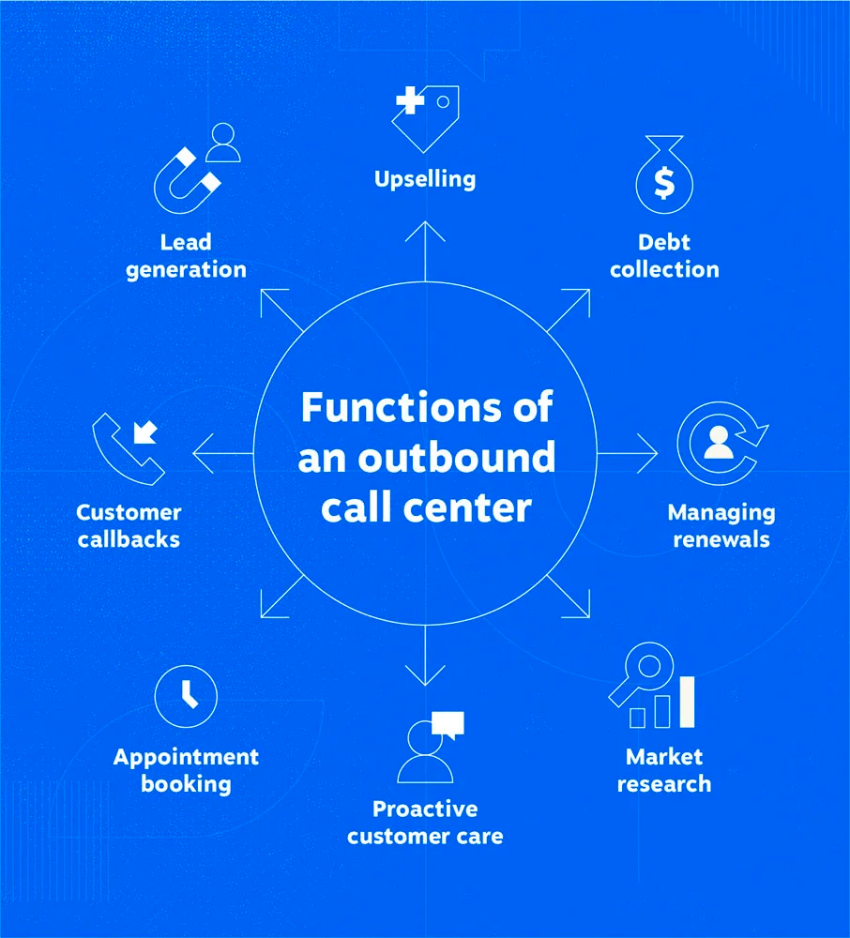
Types of outbound calls
Outbound calls serve various proactive business goals:
- Telemarketing/sales calls: Agents call potential customers to inform them about products/services, generate interest, and close sales.
- Lead generation/qualification: Calls to potential leads to gauge their interest and qualify them for further sales calls.
- Market research/surveys: Calls to gather opinions, feedback, or data for market analysis and product development.
- Customer follow-up: Tracking previous interactions, service issues, or purchases to ensure customer satisfaction or offer additional support.
- Debt collection: Calls to customers regarding overdue payments.
- Appointment scheduling: Calls to schedule meetings or demos for sales teams.
- Promotional campaigns: Inform customers about new offers, discounts, or events.
Outbound call center success KPIs
Monitoring agent performance in an outbound call center is critical to maximizing your business success:
- Answer success rate: (Number of calls answered ÷ total number of calls made) × 100
- Lead conversion rate: (Number of successful outcomes ÷ total number of calls made) × 100
- Average handle time (AHT): [(Total talk time + hold time + after-call work time) ÷ total number of calls made] × 100
- Cost per call: Total operational cost ÷ total calls made
- Cost per acquisition (CPA): Total cost of call campaign ÷ number of new customers acquired
- Contact rate: Percentage of calls that successfully connect with a person.
- Talk time: Actual time spent talking to customers.
Outbound call center benefits
Due to their proactive approach, outbound call centers have several benefits for your business.
Boosts lead generation and sales
According to HubSpot, 15% of marketers struggle to generate leads. Outbound call agents relieve the pressure on the marketing and inbound sales teams by skillfully identifying prospects who are likely to turn into customers.
They access customer data to target pain points and persuade customers to move forward in the sales funnel. A personalized interaction opens up selling or cross-selling opportunities.
Increases brand awareness
Businesses can tailor brand communications to the interests of their target market through outgoing calls. Since customers value human interaction, they’ll notice your brand more when engaging in meaningful conversation.
Reps can proactively inform customers about your product offerings or service quality and build good relationships. When it’s time to purchase, these callers are more likely to remember your brand.
Conduct market research
You can learn what customers want through outbound call centers. By directly engaging with your buyers, you uncover valuable information about their needs, preferences, motivations, trends, etc. This concrete market research lets you invest more confidently in updating your services and developing your products.

Technologies That Inbound and Outbound Call Center Software Use
Call centers, whether inbound, outbound, or blended, use sophisticated software to manage communications, streamline processes, and improve the customer experience. They also integrate different features to improve call center productivity and performance.
Inbound call center software features
The following call center features manage and route incoming calls to connect customers to the right agent as quickly as possible.
- Automatic call distribution (ACD): Intelligently routes incoming calls to the appropriate agent based on predefined criteria such as skills, availability, or the customer’s IVR selection.
- Interactive voice response (IVR): An automated phone system that interacts with callers, gathers information, and routes them without a live agent. IVR allows callers to navigate through a menu using a keyboard or voice command to reach the correct department or access self-service options.

Outbound call center software features
Outbound call center tools maximize agent efficiency and contact rates for proactive outreach campaigns.
- Predictive dialers: Automatically dial multiple numbers at once from a contact list. The system uses algorithms to predict agent availability and connects them only when a live person answers, reducing idle time.
- Power dialers: Automatically dial one number after another for an agent, eliminating the need for them to dial manually. This is a less aggressive but still highly efficient option.
- Auto dialers: A simpler form of automation that dials phone numbers from a list and can either play a pre-recorded message or connect to a live agent when the call is answered.
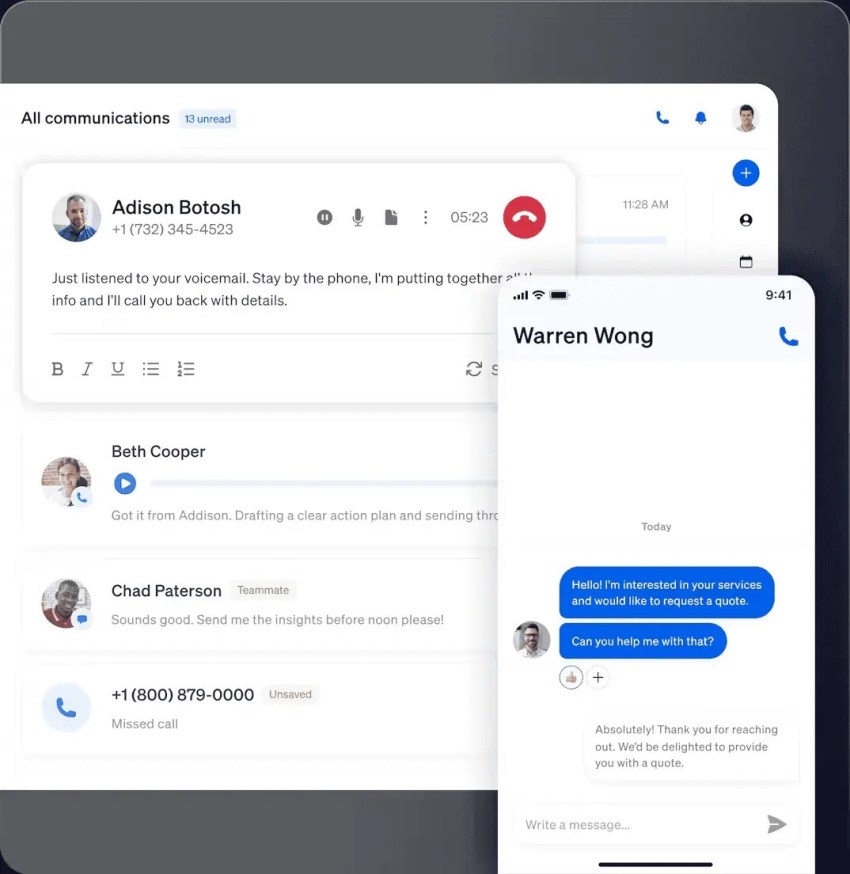
Essential features for both inbound and outbound call centers
The following call center software features provide the context, quality control, and data insights needed for any successful call center operation.
- Customer relationship management (CRM) integration: Provides agents with instant access to caller data, purchase history, and previous interactions. This translates to personalized support for inbound calls and tailored sales conversations for outbound calls.
- Call recording and monitoring: Allows managers to record calls for quality assurance, compliance, and agent training for improving support scripts (inbound) and sales techniques (outbound).
- Real-time analytics and reporting: Provides live dashboards and detailed reports on key performance indicators. Managers can track inbound metrics such as wait times and first call resolution rates, as well as outbound metrics such as conversion rates and calls per hour.
- Omnichannel support: Integrates all communication channels, including phone, email, web chat, and social media, into a unified platform. Agents get a complete view of the customer journey, whether resolving support tickets or nurturing sales leads.
- Workforce management (WFM): Helps managers forecast call volumes, create optimal agent schedules, and ensure adequate staffing levels to meet demand — critical for both managing inbound peaks and planning outbound campaigns.
Popular Inbound and Outbound Call Center Software Providers
Many providers offer inbound and outbound call center solutions equipped with AI-powered features for optimal performance. Some notable call center software providers include:
- Nextiva: Offers an AI-powered contact center solution with omnichannel engagement, process automation, real-time dashboards, and AI-powered transcription and summarization.
- RingCentral Contact Center: Known for omnichannel support, cloud telephony, business texting, and video conferencing.
- Five9: Cloud-based solution with AI-powered call routing and powerful CRM integrations.
- Zendesk Talk: Suitable for small and medium-sized businesses, it integrates well with more comprehensive customer service platforms.
- CloudTalk: Offers inbound and outbound calling capabilities, especially useful for remote teams.
- Talkdesk: Offers omnichannel customer service and real-time insights into the customer journey.
| Provider | Best for | Key feature | Omnichannel? |
|---|---|---|---|
| Nextiva | Businesses of all sizes that need an all-in-one communication platform (UCaaS + CCaaS). | Tightly integrated suite for voice, video, and contact center with a strong reputation for reliability. | ✅ |
| RingCentral | Large businesses that need a feature-rich platform with deep CRM integrations. | Global presence and powerful integrations, especially with Salesforce. | ✅ |
| Five9 | Mid-market and enterprise teams looking for a powerful, AI-driven cloud solution. | Advanced AI features for intelligent routing, agent assistance, and analytics. | ✅ |
| Zendesk Talk | Businesses already using the Zendesk ecosystem for customer support. | Native integration with Zendesk’s ticketing and help desk software. | ✅ |
| CloudTalk | Remote or distributed sales and support teams in small to mid-sized businesses. | Strong focus on call quality, international calling, and sales-centric features like power dialers. | ✅ |
| Talkdesk | Enterprise customers in specific industries (retail, healthcare) that need custom solutions. | AI-powered Customer Experience Cloud™ with industry-specific security and compliance features. | ✅ |
Choosing the Right Call Center Type for Your Business
Inbound and outbound call centers fulfill distinct purposes and serve different target audiences.
For example, service-oriented businesses, like those in healthcare or banking, benefit from having an inbound call center to resolve customer concerns. Conversely, businesses focused on acquiring new customers and demographics, like those in the retail sector, need an outbound call center.
The choice depends on how you operate and in which industry. Let’s identify the right match for your business needs.
Consider your business goals
Align your strategy with your short- and long-term business goals. Are you looking for scalability? Do your short-term goals involve introducing new products, entering new markets, capturing more leads, etc.? In this case, a strong outbound call center team can help.
However, you need an inbound call center strategy if you already have a solid customer base and want to increase customer satisfaction and retention.
If you are struggling to decide, you can check in with your team to see where they are struggling and choose your type of call center accordingly.
Analyze your customer base
Evaluate your customer’s expectations. If your customers value after-sales service and customer support as much as product quality, then inbound call centers contribute to a unified customer experience.
The contact center solution from Nextiva covers every social media, messaging, and business communication channel. It helps sales and support teams communicate with customers.
For example, if you have numerous leads stuck in the sales funnel who need a little nudge, or you need to increase brand awareness among prospects, outbound phone calls can be more successful. When your team works from one platform, it helps everyone perform better instead of using several different tools.
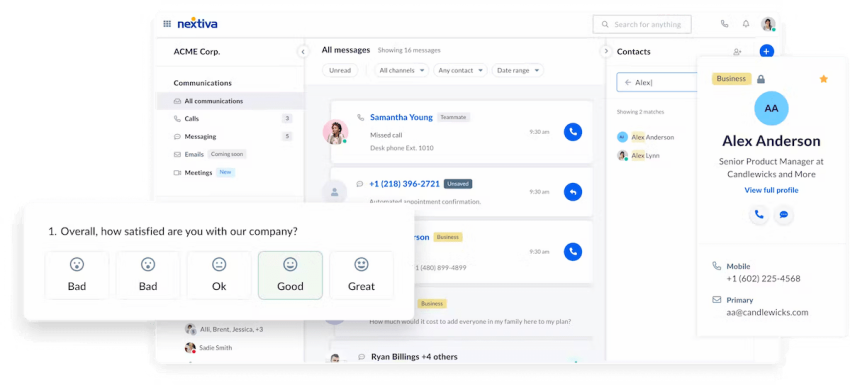
Evaluate resources
Consider the agents on your team and their training needs. Inbound calls can be complex, requiring agents who know your product and can handle customer service calls politely, professionally, and empathetically.
Outbound call agents, however, typically work with scripts and dialing lists. Sales-oriented staff with good communication and persuasion skills are best suited for this role.
Blended Call Centers Offer the Best of Both Worlds
If you can’t decide between inbound vs. outbound call centers, there is a secret option C — blended call centers. Most organizations require the benefits of inbound and outbound call centers, so they centralize their customer communications in one call center team.
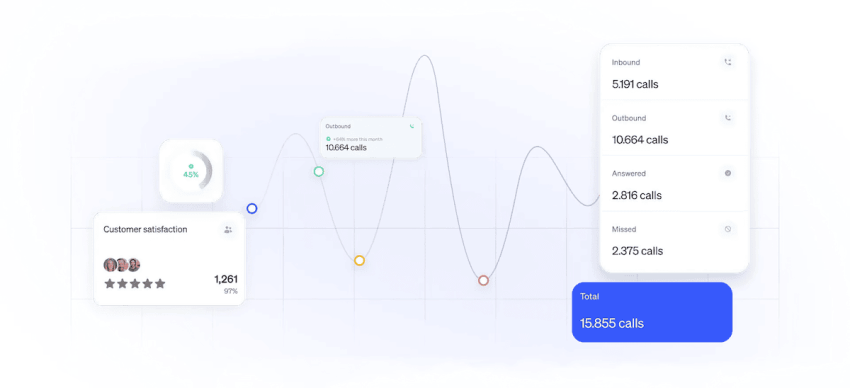
This approach brings together the best of both worlds by:
- Increasing efficiency: Since call center agents handle both inbound and outbound calls, the calling software directs customer calls to any available agent, reducing idle time among the team and waiting time for the customer.
- Improving customer satisfaction: With one team handling proactive outreach and customer support, callers don’t have to jump on multiple calls to get what they need. This approach increases customer satisfaction rates.
- Capturing sales and leads: You can train agents to convert interest or generate new sales from inbound calls through personalized interactions. Potential customers feel comfortable taking action or moving through the sales process when they have built a connection with an agent.
- Adding flexibility: A centralized communications system gives agents a holistic view of customer profiles and past interactions. Agents can quickly switch between inbound and outbound calls when tackling high call volumes, as all data is available in one place.
Considerations when choosing a blended call center
A blended team has many benefits, but you might also encounter challenges. Awareness of these issues helps you take proactive or preventive steps and keep your team running smoothly.
- Training: Training agents to hone diverse skills and handle both call types requires time and effort. Specialized training is needed to help them address complex issues, different temperaments, and high call volumes. But this effort will pay off in the long run.
- Technology: Blended call software can be complex and costly, and it can take a while for your team to get the hang of it. However, many reasonably priced cloud call center software applications blend inbound and outbound call center services. You should conduct thorough research to find an intuitive tool at a suitable cost.
- Call patterns: It is important to strike the right balance between inbound and outbound call patterns. If your agents are more focused on outbound calls, you risk being less available for incoming callers.
Nextiva’s Blended Call Center Platform
When you consider the above pointers and plan accordingly, a flexible call center platform adds substantial value to your business. It gives your customers a consistent communication experience regardless of whether they’re dealing with your sales or support team.
Call center software by Nextiva has been a valuable choice for many companies dealing with inbound and outbound calls. It helps your business satisfy customer needs while turning call centers into lead-generation engines.
Optimize your call center operation.
Maximize your team’s productivity effortlessly and see why top brands use Nextiva to handle calls at scale.
Inbound vs. Outbound Call Center FAQs
The key differences between inbound and outbound call centers are found in their purpose and approach. Inbound calls come from customers reaching the business. Examples include technical support, billing inquiries, product questions, appointment setting, order processing, and answering questions. Outbound calls are initiated by agents. These often include prospective customers, lead follow-ups to potential clients, customer satisfaction surveys, payment reminders, and service renewal reminders.
Both have challenges. Inbound call centers require inbound call center agents to resolve issues quickly, manage high-volume calls, keep customers satisfied, and stay composed under pressure. But customers initiate the contact, so the interaction is usually more constructive than cold calling.
Outbound call centers are harder in terms of persistence and resilience since agents face frequent rejections, strict quotas, pressure to convert calls into sales or leads, and must meet outreach targets.
Many businesses run blended call centers where agents manage both types of calls. They answer incoming calls during peak hours and switch to outbound calls when traffic slows. Agents may alternate between handling customer service inquiries and contacting prospective customers, performing tasks like order processing or appointment setting. This setup keeps call flow balanced and agents productive, but it demands strong multitasking and the ability to adjust their approach for each call type.
The answer depends on the business model and goals. Inbound fits service-driven companies like clinics or repair shops, where customers expect quick support. Outbound works better for sales-focused businesses such as real estate agencies or startups that focus on sales growth, lead generation, or reaching potential clients. Some small businesses find a hybrid approach better and use inbound for support and limited outbound for targeted growth.
Inbound agents need empathy, active listening, and problem-solving to understand issues, resolve them quickly, and create a positive customer experience. Outbound agents depend on persuasion, resilience, and rapport-building. They must overcome objections, handle rejection without losing momentum, and guide prospects toward a decision while keeping the conversation natural and engaging without sounding pushy.
Sales and telemarketing are common, but outbound call centers cover much more. They also handle collections, appointment scheduling, reminders, fundraising, customer feedback surveys, and market research. In short, any proactive communication from a business to its customers qualifies as outbound, and it isn’t limited to sales pitches.


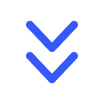














 Customer Experience
Customer Experience 











